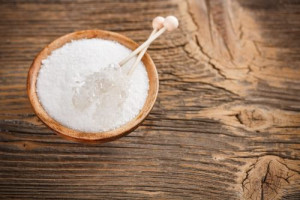Xylitol
NEWS: This superfood is now available in the SANEStore as a convenient whole-food powder so you can more easily enjoy it in smoothies and recipes.

Xylitol is a sugar alcohol that is naturally present in small amounts in various fruits and vegetables. It was originally extracted from birch trees in Finland. Our Xylitol is derived from non-GMO corn. It is comparable to xylitol derived from other sources, such as birch. Xylitol is normal part of the human metabolism. In fact, our bodies make up to 15 grams of it daily.

Xylitol resembles sugar in consistency and taste (about 80% as sweet as sugar), but has 40 percent fewer calories and 75 percent fewer carbohydrates than sugar. Additionally, xylitol is not easily converted to fat and has almost no effect on insulin levels, making it a great alternative for diabetics, bodybuilders and dieters. Xylitol also is considered safe for pregnant and nursing women, babies and children. Xylitol tastes wonderful. There’s no strange diet taste and kids love it.
Additionally, xylitol has been found to increase the activity of white blood cells involved in fighting bacteria and thus may help build immunity, protect against chronic degenerative disease and have anti-aging benefits. It has been proven effective in inhibiting Candida albicans, a serious yeast condition, and other harmful bacteria, including H. pylori, which is implicated in gum disease, bad breath, ulcers and stomach cancer.
Using xylitol instead of sugar and/or refined carbohydrate foods may help to lower the risk of polycystic ovarian syndrome (a condition that disrupts or stops the ovulation cycle), ovarian cysts, fibroids, endometriosis, and premenstrual syndrome. Research shows that dietary xylitol prevents weakening of bones in rats and improves bone density, indicating xylitol’s potential to support healthy bones in humans.
Why Try Xylitol Superfood ?
- Clean taste like regular sugar (about 80% as sweet as sugar) without the negative effects
- Antimicrobial properties help prevent tooth decay by inhibiting Candida albicans
- Regular use of xylitol by mothers reduces the transmission of Streptococcus mutans to children by up to 80 percent during the first two years
- Reducing bone loss caused by osteoporosis
- Xylitol enhances mineral absorption in tooth enamel, increasing its strength.
- Consistently using small amounts of xylitol stimulates saliva flow & increases saliva’s buffering capacity & protective factors
- Reducing the incidence of new tooth decay & arrest existing dental cavities
- Increases absorption of calcium
- Inhibiting H. pylori
- Mild laxative effects
- Reduce the incidence of sinus infections, allergies & asthma when used as a nasal wash
References
1. B. L. Horecker, K. Lang, Y. Takagi (eds), International symposium on metabolism, physiology and clinical uses of pentoses and pentitols Springer-Verlag, Berlin, 1969. Proceedings of symposium held in Hakone, Japan August 27-29, 1967 about xylitol before major dental benefits were demonstrated.
2. H. L. Sipple, K. W. McNutt (eds) Sugars in Nutrition Academic Press, New York 1974. Xylitol featured in several sections including: Sugars in foods, recent technological developments, digestion and absorption of sugars, metabolism of sugars, diabetes, therapeutic use of sugars, and sugars in the oral cavity.
3. A. Scheinin, K.K. Mäkinen (eds) The Turku Sugar Studies, I-XXI Acta Odontologica Scandinavia, vol. 33, supplement 70, 1975. The classic series of investigations which revealed the remarkable potential of xylitol.
4. J. N. Counsell (ed) Xylitol Applied Science, London, 1977. Collects and updates xylitol findings at an International Symposium in London, May 5, 1977. Includes discussions of xylitol as a new ingredient along with biochemical and dental aspects of xylitol..
5. K. K. Mäkinen, Biochemical principles of the use of xylitol in medicine and nutrition with special consideration of dental aspects Birkhäuser Verlag, Basel, 1978. This monograph details virtually all xylitol-related research published before 1978 on dental caries, oral microbiology, human physiology, and animal and human nutrition.
6. J. J. Hefferen, H. M. Koehler (eds) Foods, Nutrition and Dental Health Pathotox Publishers, Park Forest South, IL 1981. Contains interesting background “discussions” including insights into the original xylitol programs.
7. W. J. Loesche, Dental Caries, a Treatable Infection University of Michigan, 1987. “S. mutans and L. casei can ferment sorbitol and mannitol (sweeteners in sugar-free gum) but are inactive towards xylitol. Xylitol is comparable to sucrose in sweetness and has been shown to be noncariogenic, possibly anticariogenic.”
8. I. D. Mandel (chairman), Dental Dialogue — Caries Prevention with Xylitol (synopsis of symposium held at University of Michigan) Medec Communications, Oradell NJ 1988. “Clearly, xylitol exhibits more dental benefits than any other sweetener. We are talking about xylitol not as a sole preventive agent but as an agent used in conjunction with available preventive services.”
9. T. H. Grenby (ed) Progress in Sweeteners Elsevier Applied Science, London, 1989. Includes sections on dental considerations and xylitol in caries limitation.A. J. Rugg-Gunn (ed) Sugarless, the Way Forward: Proceedings of an International Symposium Held at the University of Newcastle at Tyne, U.K. Elsevier Applied Science, London, September 1991. General information about sugar substitution along with some specific topics such as sweeteners in children’s medications, mostly from the British and European regulatory perspective.
10. N. Kretchmer, C. B. Hollenbeck (eds) Sugars and Sweeteners CRC Press, London 1991. See chapters 8-10.
11. A. J. Rugg-Gunn, (with) A. F. Hackett, Nutrition and Dental Health Oxford University Press, 1993. “There is no doubt that xylitol is the most expensive sweetener (about ten times more expensive than sucrose).”
12. J. N. Peldyak, Sweet Smart – Xylitol Advanced Developments, MI, 1996. Focuses on dental aspects of sugars and sweeteners with practical consumer advice on xylitol use.
13. A. J. Rugg-Gunn, J. H. Nunn, Nutrition, Diet and Oral Health Oxford Un.








